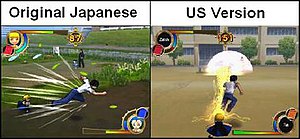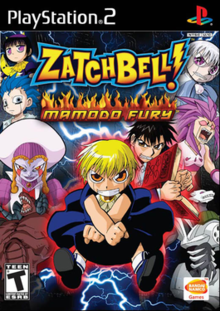|
Zatch Bell! Mamodo Fury
Zatch Bell! Mamodo Fury (金色のガッシュベル!! 激闘!最強の魔物達, Konjiki no Gash Bell!! Gekitou! Saikyou no mamonotachi, lit. Golden Gash Bell!! Clash! Strongest Demons) is a fighting game released on the PlayStation 2.[1] The original Japanese version was published by Bandai at the end of 2004, after merging with Namco but before the formation of Namco Bandai Games. The subsequent international releases and the GameCube versions were published under Namco Bandai Games.[2] The game is based on the Zatch Bell! franchise.[1] PlotEvery 1,000 years, 100 mamodo children are sent to earth. Each mamodo child comes with a spellbook, which will unleash strong powers when read by a human partner. The mamodo and human will then battle other mamodo for the title of the next "Mamodo King". If the spellbook is destroyed in battle, a mamodo will lose all chance of becoming King, and will return to the Mamodo World forever. The last one standing without their book burned will be crowned the King. Kiyo Takamine is a 14-year-old Japanese boy genius who is bullied at school for his intellect. As a result, he is socially inept and has trouble making friends. Concerned, Kiyo's father, a professor teaching in England sends a young boy named Zatch Bell to help him. Kiyo's father found Zatch dying in a nearby forest, where he had lost all of his memory except for his name, and also with the young boy, a mysterious book. It is soon discovered that Zatch is one of the mamodo competing for King, and after seeing a kindhearted mamodo named Kolulu fight against her will, he vows to become a benevolent Mamodo King and stop the fighting. A few months later, the number of mamodo left on earth is down to 40 as an evil mamodo named Zofis rises. He had recently discovered that many mamodo from the previous battle a millennia ago were turned to stone along with their spellbooks by the legendary Goren of the Stone, also from the previous battle. Zofis revives the Ancient Mamodo with he mysterious "stone of moonlight" and brainwashes humans into reading their spellbooks, creating a whole new army of minions, planned to be sent out to defeat the remaining mamodo in order to become King. Zatch and Kiyo learn about his plan and battle their way through his army and finally confront Zofis. Right after Zofis is sent back to the Mamodo World by the once again victorious Zatch Bell, a mysterious figure appears. The figure is a mamodo child who looks like Zatch, named Zeno, who claims to hate Zatch more than anything. The doppelgänger and his partner, Dufort prove to be tough for Kiyo and Zatch, and finally, Zeno declares that he will leave them alone for now, stating that he wants Zatch to "suffer" another "living nightmare" before finally defeating him. Zeno and Dufort leave, and although Zatch is initially worried about the "nightmare" his lookalike mentioned, Kiyo encourages him to become strong and that they will never give up. Zatch agrees, and the two proceed on, prepared for another adventure. Game modesStory Mode: Play is done over the course of 40 levels consisting of different opponents. Often special conditions will need to be met, such as defeating an opponent with Bao Zakeruga. Note that this does not necessarily mean that the opponent be at minimum health. In addition to the regular Story Mode there is a series of mini games which are consolidated into "Zatch's Diary". These follow every day situations in Zatch's life. Previously played levels can be reselected either to improve rating or on higher difficulties. Arcade Mode: Choose a character and fight against eight opponents. Once completed, a special cut-scene for the chosen character will play that contains dialogue between the mamodo and his or her partner. After the scene concludes you will see the statistics of all eight matches. These statistics determine the chance of the mamodo becoming King. To receive a 100% rating, all matches must be won with an "A" rating. VS. Mode: This is a traditional one-on-one battle. Choose any character and stage and begin fighting immediately. Play can either be against CPU opponents or other people via two controllers. A ranking up system is also available. Stats for individual characters can be upgraded by the obtaining of "Mamodo Points", which are distributed after the conclusion of a match. The number of points given is based on the aforementioned ranking system, with "A" being the best and "E" being the worst. 4P Battle: Meant as more of a party mode, the 4P battles are in the form of mini games. These include "Burn the Spell Book", which has each player try to kick another's spell book into a small campfire, among others. Mini-Games: This game mode contains seven mini games where certain goals must be completed. One level requires you to find 30 lollipops and give them to Kanchome within 80 seconds. Gallery: The Gallery is split into several subtypes: the Model Gallery, which shows all the character models used in the game along with a short description of each; Visual Gallery, which has all the cut scenes from the Story Mode; Stage Gallery, which lets the player control Suzy Mizuno and roam freely along the multiplayer stages; and the Sound Gallery, which contains all the music from the game. Changes to the US version
ReceptionReception
References
External links |
||||||||||||||||||||||||||||||||
